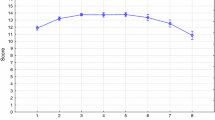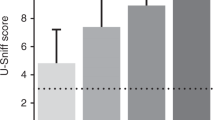Abstract
Background
A card-type odor identification test called the “Open Essence (OE),” consisting of 12 types of everyday odors familiar to Japanese people, was recently developed. In this study, we calculated the cut-off value of the OE score for screening for age-related olfactory decline.
Methods
Participants aged 23 to 91 performed the OE test. After we confirmed that the OE score differed significantly between young/middle-aged adults (under 65 years old) and elderly adults (over 65 years old), we assumed that the young/middle-aged group had normal olfactory ability, whereas the elderly group had experienced a decline in odor identification ability. We then performed receiver operating characteristic (ROC) analysis using the OE score.
Results
The cut-off value of the OE score for screening for age-related olfactory decline, calculated on the basis of the ROC curve, was 8.
Conclusion
Individuals with the OE scores of 7 or less may have age-related olfactory decline. Our finding suggests that this cut-off value could be used to screen Japanese people with age-related olfactory decline.
Implication
The OE test is self-administered and has a cut-off value of the OE score for screening for age-related olfactory decline. Therefore, it is expected to be useful in mass screening for elderly adults.



Similar content being viewed by others
References
Abramczyk RR, Jordan DE, Hegel M (1983) “Reverse” Stroop effect in the performance of schizophrenics. Percept Mot Skills 56(1):99–106
Ayabe-Kanamura S, Saito S, Naito N, Mise M, Gotow N, Ichikawa H, Deguchi Y, Kobayakawa T (2005) Odor identification in different age and gender groups assessed by the odor stick identification test (OSIT). Aroma Res 24:368–371 in Japanese
Doty RL (1997) Studies of human olfaction from the University of Pennsylvania Smell and Taste Center. Chem Senses 22(5):565–586
Doty RL (2009) Sensory aging: chemical senses. In: Hof PR, Mobbs CV (eds) Handbook of the neuroscience of aging. Academic Press, London, pp 215–222
Doty RL, Jackman AH (2009) Olfaction and gustation. In: Snow JB, Ballenger JJ (eds) Ballenger’s otorhinolaryngology: head and neck surgery (17th edition). People’s Medical Publishing house, Shelton, pp 465–479
Doty RL, Laing DG (2015) Psychophysical measurement of human olfactory function. In: Doty RL (ed) Handbook of olfaction and gustation, 3rd edn. Wiley & Sons, Hoboken, New Jersey, pp 227–260
Doty RL, Shaman P, Dann M (1984a) Development of the University of Pennsylvania Smell Identification Test: a standardized microencapsulated test of olfactory function. Physiol Behav 32(3):489–502
Doty RL, Shaman P, Kimmelman CP, Dann MS (1984b) University of Pennsylvania Smell Identification Test: a rapid quantitative olfactory function test for the clinic. Laryngoscope 94(2 Pt 1):176–178
Folstein MF, Folstein SE, McHugh PR (1975) “Mini-mental state”: a practical method for grading the cognitive state of patients for the clinician. J Psychiatr Res 12(3):189–198
Fujio H, Doi K, Hasegawa S, Kobayakawa T, Nibu K (2012) Evaluation of card-type odor identification test for Japanese patients with olfactory disturbance. Ann Otol Rhinol Laryngol 121(6):413–418
Fujio H, Inokuchi G, Fukuda Y, Kuroki S, Kokan N, Nibu K (2018) A new screening tool, an odor identification test card to detect age-related changes in olfaction. J Otolaryngol Jpn 121(1):38–43 in Japanese
Gregorio LL, Caparroz F, Nunes LMA, Neves LR, Macoto EK (2014) Olfaction disorders: retrospective study. Braz J Otorhinolaryngol 80(1):11–17
Hakoda Y (2005) New Stroop test II–methods & data reduction–(Shin Stroop test II–Kensa no jisshi seiri ho–). Toyo Physical, Fukuoka in Japanese
Hashimoto Y, Fukazawa K, Fujii M, Takayasu S, Muto T, Saito S, Takashima Y, Sakagami M (2004) Usefulness of the odor stick identification test for Japanese patients with olfactory dysfunction. Chem Senses 29(7):565–571
Henik A (1996) Paying attention to the Stroop effect? J Int Neuropsychol Soc 2(5):467–470
Hummel T, Kobal G, Gudziol H, Mackay-Sim A (2007) Normative data for the “Sniffin’ Sticks” including tests of odor identification, odor discrimination, and olfactory thresholds: an upgrade based on a group of more than 3,000 subjects. Eur Arch Otorhinolaryngol 264(3):237–243
Hummel T, Sekinger B, Wolf SR, Pauli E, Kobal G (1997) ‘Sniffin’ Sticks’: olfactory performance assessed by the combined testing of odor identification, odor discrimination and olfactory threshold. Chem Senses 22(1):39–52
Hüttenbrink K-B, Hummel T, Berg D, Gasser T, Hähner A (2013) Olfactory dysfunction: common in later life and early warning of neurodegenerative disease. Dtsch Arztebl Int 110(1–2):1–7
Ikeda Y, Hirata S, Maeda W, Okuzumi H, Kokubun M, Ambe H, Fujieda Y, Suijo K, Hayashi J, Iteya M (2013) Relationship between Stroop/reverse-Stroop interference and postural sway when standing in elderly people. Compr Psychol 2:9
Kim HY (2014) Olfaction and neurodegenerative disease. Hanyang Med Rev 34(3):116–119
Kobal G, Klimek L, Wolfensberger M, Gudziol H, Temmel A, Owen CM, Seeber H, Pauli E, Hummel T (2000) Multicenter investigation of 1,036 subjects using a standardized method for the assessment of olfactory function combining tests of odor identification, odor discrimination, and olfactory thresholds. Eur Arch Otorhinolaryngol 257(4):205–211
Kobayashi M, Imanishi Y, Ishikawa M, Oishi M, Nakamura S, Sakaida H, Majima Y, Maeda T, Furuta S, Tsunoda T, Matsuura T, Nishida K, Takashima Y, Saito S (2004a) The odor stick identification test for the Japanese (OSIT-J) in patients suffering from an olfactory disturbance: effects of aging on the OSIT-J and its suitability as a smell detection test. Jpn J Rhinol 43(2):167–174 in Japanese
Kobayashi M, Nishida K, Nakamura S, Oishi M, Shiozaki T, Majima Y, Maeda T, Furuta S, Takashima Y, Saito S (2004b) Suitability of the odor stick identification test for the Japanese in patients suffering from olfactory disturbance. Acta Otolaryngol Suppl 553:74–79
Kobayashi M, Reiter ER, DiNardo LJ, Costanzo RM (2007) A new clinical olfactory function test: cross-cultural influence. Arch Otolaryngol Head Neck Surg 133(4):331–336
Kobayashi M, Saito S, Kobayakawa T, Deguchi Y, Costanzo RM (2006) Cross-cultural comparison of data using the odor stick identification test for Japanese (OSIT-J). Chem Senses 31(4):335–342
Lötsch J, Hummel T, Ultsch A (2016) Machine-learned pattern identification in olfactory subtest results. Sci Rep 6:35688
Makizako M, Makizako H, Doi T, Uemura K, Tsutsumimoto K, Miyaguchi H, Shimada H (2014) Olfactory identification and cognitive performance in community-dwelling older adults with mild cognitive impairment. Chem Senses 39(1):39–46
Matsumoto A, Hakoda Y, Watanabe M (2012) Life-span development of Stroop and reverse-Stroop interference measured using matching responses. Jpn J Psychol 83(4):337–346 in Japanese
Michoux N, Guillet A, Rommel D, Mazzamuto G, Sindic C, Duprez T (2015) Texture analysis of T2-weighted MR images to assess acute inflammation in brain MS lesions. PLoS One 10(12):e0145497
Miwa T, Furukawa M, Tsukatani T, Ikeno S, Yata T, Horikawa I, Deguchi Y, Saito S (2004) Clinical usefulness of odor stick identification test for patients with olfactory disturbance. J Otolaryngol Jpn 107(10):956–965 in Japanese
Nishida K, Kobayashi M, Ogihara H, Takeo T, Kitano M, Takeuchi K (2010) Clinical usefulness of smell identification test card: open essence. J Otolaryngol Jpn 113(9):751–757 in Japanese
Pinto JM (2011) Olfaction. Proc Am Thorac Soc 8(1):46–51
Ruopp MD, Perkins NJ, Whitcomb BW, Schisterman EF (2008) Youden Index and optimal cut-point estimated from observations affected by a lower limit of detection. Biom J 50(3):419–430
Saccess-Bell (2019) New Stroop Test II. Retrieved from http://www.saccess55.co.jp/kobetu/detail/stroop.html
Saito S, Ayabe-Kanamura S, Kobayakawa T, Kuchinomachi Y, Takashima Y (1999) A smell test based on odour recognition by Japanese people, and its application. In: Bell GA, Watson AJ (eds) Tastes & aromas: the chemical senses in science and industry. University of New South Wales Press, Sydney, pp 75–82
Saito S, Ayabe-Kanamura S, Takashima Y, Gotow N, Naito N, Nozawa T, Mise M, Deguchi Y, Kobayakawa T (2006) Development of a smell identification test using a novel stick-type odor presentation kit. Chem Senses 31(4):379–391
Sakuma Y (2014) Cognitive developmental features of first (Japanese) and foreign (English) languages in students who participated in elementary school foreign language activities: reverse-Stroop and Stroop effects. Bull Fac Hum Dev Cult Fukushima Univ 20:1–16 in Japanese
Sanke H, Mita T, Yoshii H, Yokota A, Yamashiro K, Ingaki N, Onuma T, Someya Y, Komiya K, Tamura Y, Shimizu T, Ohmura C, Kanazawa A, Fujitani Y, Watada H (2014) Relationship between olfactory dysfunction and cognitive impairment in elderly patients with type 2 diabetes mellitus. Diabetes Res Clin Pract 106(3):465–473
Shino M, Furuta A, Uchida J, Ooki S, Harumi S (2006a) Odor stick identification test for Japanese patients with olfactory disturbances. J Otolaryngol Jpn 109(9):689–695 in Japanese
Shino M, Furuta A, Uchida J, Yokomori E, Suzuki E, Ooki S, Saito S, Deguchi Y, Suzaki H (2006b) The evaluation of the odor stick identification test for Japanese (OSIT-J) in patients with olfactory disturbances. Jpn J Rhinol 45(2):148–153 in Japanese
Song Y, Hakoda Y (2011) An asymmetric Stroop/reverse-Stroop interference phenomenon in ADHD. J Atten Disord 15(6):499–505
Srivastava S (2017) The mitochondrial basis of aging and age-related disorders. Genes 8(12):398
Stroop JR (1935) Studies of interference in serial verbal reactions. J Exp Psychol 18(6):643–662
Uchiyama H, Fukumoto I (2006) A cognitive function self-training system by Stroop effect task. In: Kim SI, Suh TS (eds) IFMBE Proceedings, vol 14/1. Springer, Berlin, pp 3758–3762
Watanabe Y, Suzuki K, Miyamoto T, Miyamoto M, Numao A, Fujita H, Uchiyama T, Kadowaki T, Matsubara T, Hirata K (2017) A card-type odor identification test for Japanese patients with Parkinson’s disease and related disorders. Intern Med 56(21):2871–2878
Wingert NC, Gotoff J, Parrilla E, Gotoff R, Hou L, Ghanem E (2016) The ACS NSQIP risk calculator is a fair predictor of acute periprosthetic joint infection. Clin Orthop Relat Res 474(7):1643–1648
Youden WJ (1950) Index for rating diagnostic tests. Cancer 3:32–35
Yun J-Y, Lee DY, Seo EH, Choo IH, Park SY, Kim SG, Woo JI (2011) Neural correlates of Stroop performance in Alzheimer’s disease: a FDG-PET study. Dement Geriatr Cogn Dis Extra 1(1):190–201
Funding
This study was partially supported by JSPS KAKENHI Grant Nos. 16KT0011, 16K04418, 18H03665, and 18KT0033.
Author information
Authors and Affiliations
Corresponding author
Ethics declarations
Conflict of Interest
The authors declare that they have no competing interests.
Ethical Approval
All procedures performed in studies involving human participants were in accordance with the ethical standards of the ergonomic experiments committee of the National Institute of Advanced Industrial Science and Technology, as well as with the 1964 Helsinki Declaration and its later amendments or comparable ethical standards.
Informed Consent
Informed consent was obtained from all individual participants included in the study.
Additional information
Publisher’s Note
Springer Nature remains neutral with regard to jurisdictional claims in published maps and institutional affiliations.
Rights and permissions
About this article
Cite this article
Gotow, N., Yamamoto, K., Kobayashi, T. et al. Screening for Age-Related Olfactory Decline Using a Card-Type Odor Identification Test Designed for Use with Japanese People. Chem. Percept. 14, 1–10 (2021). https://doi.org/10.1007/s12078-020-09279-8
Received:
Accepted:
Published:
Issue Date:
DOI: https://doi.org/10.1007/s12078-020-09279-8




